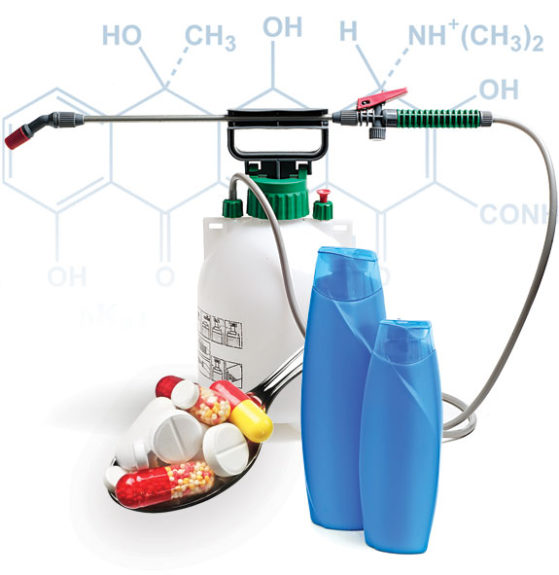Recent advances in laboratory analytical techniques now allow scientists to detect organic compounds at very low concentrations, in the parts-per-billion to parts-per-trillion range. As detection limits have dropped and as scientists have begun to test for more and more chemicals, previously undetected organic chemicals are increasingly being found in streams, lakes and groundwater. These previously undetected chemicals, typically synthetic chemicals released from human activities on the land surface, are now popularly referred to as “emcons” or “emerging contaminants.”
Emcons include pharmaceuticals, antibiotics, hormones, detergents, disinfectants, plasticizers, fire retardants, pesticides and antioxidants.
The term “emerging” refers to new detections of these trace chemicals, not necessarily new occurrences. The emcons, many of which have been in use for years, may actually have been present in the environment, undetected, for quite some time.
How did this area of study originate?
In the late 1990s, researchers at the U.S. Geological Survey (USGS) observed that European researchers unexpectedly detected a heart medication in the North Sea while sampling for pesticides.
Detection of a pharmaceutical at such a low concentration in a large body of water compelled the USGS and other researchers to begin sampling for a wide spectrum of synthetic organic chemicals in U.S. water bodies.
Most of the USGS emcon research is conducted through their toxic hydrology program, where additional information is posted on-line. Meanwhile, much remains unknown about the potential health effects to humans or aquatic organisms exposed to long-term, typically very low levels of these chemical mixtures found in the environment.
However, due to the potential effects of emcons on humans and animals, the interest in these chemicals has resulted in an explosion of scientific studies during the past five to seven years.
In 2003 and 2004, in response to fish kills and increased observations of external sores and wounds on smallmouth bass and other species, the West Virginia Department of Natural Resources and USGS researchers initiated fish-health assessments at selected sites in the Potomac River.
Although the cause of the fish kills was not discovered, 18 out of 24 fish samples showed more than 25 percent of the male bass possessing intersexual (male and female) characteristics. Often these intersex characteristics occur within the reproductive organs and are not visible externally on the fish.
News of the fish kill in the Potomac greeted senators and congressmen in their morning newspapers. Congressional hearings on pharmaceuticals and endocrine disruptors followed in 2006 and 2008.
The occurrence of intersex fish has been related to chemicals, often termed endocrine disruptors, which affect the reproductive system. Endocrine disruptors are chemicals that interact with and possibly disrupt the normal functioning of human or animal endocrine systems which regulate growth, development, metabolism and reproduction.
Endocrine disruptors include previously banned compounds, such as DDT and chlordane, and some natural and synthetic hormones, pesticides, industrial chemicals and other emcons.
Researchers have identified potential sources of endocrine disruptors to include agricultural and individual use of pesticides, green water and solid manures that may reach surface and/or groundwater through runoff and infiltration, wastewater treatment plant discharges, landfill leachate and even atmospheric deposition of chemicals via rainfall and dust.
The USGS researchers have collected and analyzed water samples from 139 streams in 30 states. Surface-water samples included sites downstream from intense urbanization or livestock production.
Although it was not a comprehensive sampling event of all U.S. rivers, antibiotics were detected in 48 percent of samples, nonprescription drugs in 81 percent, hormones in 37 percent, and detergents in 69 percent of samples.
Steroids, nonprescription drugs and insect repellent were the chemical groups most frequently detected. The USGS is in the process of surveying a wide range of wastewater contaminants in U.S. waters.
Some USGS researchers proposed that intersex and fish kills may be related because many of the killed fish appear to have had suppressed immune systems, caused by chemicals that stimulate estrogen production. Another factor in intersex development could be concentrations of hormones in surface water, such as those in birth-control pills, which often are not removed by wastewater treatment plants.
Land-applied manure contains steroids identical to human female and male hormones. In 2009, USGS researchers presented data indicating a correlation between CAFOs and “estrogenicity” (the strength of female hormonal activity from multiple dissolved chemicals) in the Shenandoah River.
Due to growing concern about estrogenic compounds in dairy manure, nine test plots were established at the University of Tennessee Dairy Experiment Station. Manure solids were applied to six of the nine plots.
Estrogen concentrations in runoff from plots that received manure solids remained below the 100 ng/l level – assumed as the minimum required to be biologically significant. Runoff concentrations from all plots decreased with time following land application of manure solids, indicating breakdown of emcons by manure-borne bacteria, ultraviolet light or other processes.
Occurrence of emcons in dairies
Antibiotics used on dairies generally include tetracycline, oxytetracycline and sulfa drugs. Depending on a dairy’s practices, milk from hospital cows is either fed to calves or placed in lagoons. For those dairies that place hospital cow milk in lagoons, the green water that is subsequently land-applied contains antibiotic residues.
Dairy manure solids and urine contain estrogen and are routinely land-applied. Predictive models to determine the fate and transport of antibiotics and estrogenic compounds from land-application fields to surface and groundwater have not been developed.
I attended the 2nd International Conference on Emcons in 2009, where I was apparently the only industry scientist in attendance. Dairy-related big-picture emcon conclusions included:
1. Testosterone, estrogen and progesterone are degraded by manure-borne bacteria
2. Degradation of hormones and endocrine disruptors can occur with the right oxygen balance
3. A positive correlation exists between CAFOs and estrogenicity in the Potomac River
4. Antibiotics occur less frequently in groundwater than in surface water
5. Dairy manure and sediments are sources for tetracycline, oxytetracycline and sulfa drugs
6. Tetracycline was detected in 82 percent of green water lagoons sampled
7. Suggested development of a federally regulated Total Maximum Daily Load (TMDL) approach for emcons
Why tracking pharmaceuticals and other Emcons in surface and groundwater will become more of an issue for dairymen and regulators in the future
In late 2010, the U.S. EPA identified a list of 1,334 chemicals to be screened for their potential to disrupt the endocrine system. Sometime in the future, EPA will investigate the need for water quality standards for emcons. Dairies and other CAFOs will be targeted along with wastewater treatment plants.
As part of research to establish TMDLs for emcons, EPA will sample receiving streams, outfall from wastewater treatment plants, green water lagoons and runoff from CAFOs to establish baseline concentrations of emcons in surface water. If EPA identifies significant concentrations of emcons in runoff from dairies, the TMDL process will limit the allowable contributions of emcons discharging into surface water.
It is highly unlikely dairies can afford the high costs of installing treatment systems to remove emcons from their green water or runoff. The best approach to ensuring that emcon discharges from our dairies are eliminated or significantly reduced is to feed hospital cow milk to calves rather than placing it into lagoons, from where it can be transported into surface or groundwater. PD
PHOTO
Although it was not a comprehensive sampling event of all U.S. rivers, antibiotics were detected in 48 percent of samples, nonprescription drugs in 81 percent, hormones in 37 percent, and detergents in 69 percent of samples. Illustration by Mercedes Opheim.





